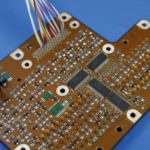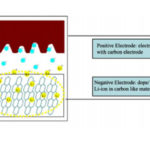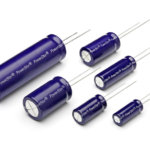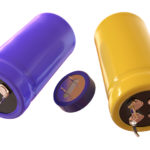There are a variety of modern applications in which supercapacitors are better candidates than either batteries or ordinary capacitors.
George Wundsam, Cornell Dubilier

Supercapacitors are not new. First developed in the 1950s, commercial versions were marketed over 40 years ago. At that time, supercapacitors were certainly not on a fast track to practical application. They were expensive, had quite low operating voltages, and were outperformed by other, more economical approaches.
Gradually, things changed. Supercapacitors (a.k.a. ultra-capacitors or EDLC capacitors) have become quite practical. Their capabilities and performance have greatly improved, with higher operating voltages, capacitance, and the ability to retain a charge. In many applications, they are now the approach of choice.
While most engineers have a basic understanding of supercaps, relatively few have put them to use. So it is helpful to discuss the applications that best fit supercaps and the pluses and minuses of the technology vs. batteries or in combination with batteries.
Lithium-ion battery technology continues to dominate global markets and will for the foreseeable future. But alternative energy storage technologies like supercapacitors are becoming more accepted as safe, scalable, efficient, and sustainable options. Instead of relying on chemicals for energy storage, as with batteries, supercapacitors store energy electrostatically and neither age nor wear out the same way batteries do. The dry electrode used in supercapacitors has a long lifespan and can be made from a variety of advanced materials such as carbon nanotubes, graphene, and carbon aerogels.
Supercapacitors have clear advantages over batteries as they have a wide operating temperature range, as well as short charge and discharge times. The short charge/discharge times arise because of their minimal internal resistance. They can be cycled hundreds of thousands, if not a million times. It is also safer to store energy in an electric field instead of chemically, thus diminishing the risk of thermal events. All in all, supercaps have a service life of between 10-15 years.
Comparing energy storage technologies
Hybrid LIC (lithium ion capacitor) supercapacitors can be charged and discharged up to 500,000 cycles; the figure is one million cycles for conventional supercaps. (LICs are called hybrids because the anode is the same as those used in lithium-ion batteries while the cathode is the same as in supercapacitors.) And unlike batteries, the energy storage capability of supercaps does not degrade with each charge/discharge cycle.
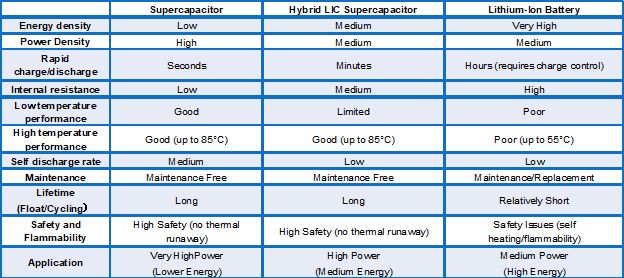
Supercapacitors serve as a key technology for preserving the environment: They provide short bursts of high power that are useful in electric vehicles and grid applications. Supercapacitors can provide main power, backup power, or pulse power. Unlike batteries, supercaps have the same efficiency during charge or discharge. This property enables the supercapacitor to recharge quickly without current limiting, provided the current is within the supercap ratings.
Supercapacitors are offered in a full range of capacitance values, in single-cell or modular configurations. Supercap modules allow virtually unlimited working voltages or capacitance. As a result, supercap applications span milliamp or milliwatt levels on up to several hundred amps or several hundred kilowatts.
Electrolytic capacitors have long been critical components in uninterruptible power supplies. The capacitors let the UPS kick in quickly, while lead-acid and lithium-Ion batteries handle the power requirements for sustained backup. But supercapacitors can supply bulk storage with less volume and fewer components. They have become a maintenance-free alternative to lead-acid batteries and lithium-Ion for short-term and bridge power applications. For example:
In data centers and cloud computing, supercapacitor-based UPS systems can reliably provide 15-30 seconds of power. Their wide temperature ranges and safety make such systems candidates for use in hospitals and other critical backup applications. The newer designs also eliminate the high costs associated with battery maintenance and replacement.
In electronics/semiconductor manufacturing, two seconds of ride-through time is required per SEMI F47. Here too, the benefits of long-term reliability (500K+ power cycles), maintenance-free operation, and design flexibility have been recognized.
Supercapacitors have become a good source of backup power for Internet-enabled wireless data terminal products. In the automotive industry, they support innovative analytics, business intelligence, driver identification, location, and data management. Supercapacitors extend device connectivity by providing highly reliable power to capture and transmit real-time data if the device is unexpectedly disconnected.
In another recent application, CDE worked with a manufacturer of barcode scanners for use in point of sale (POS) systems. These handheld scanners incorporate power-consumption management to prolong overall battery life, provide last-gasp functions and battery “hot-swap” support. CDE supercapacitors contribute to the scanners’ power efficiency by delivering lower power drain, saving an estimated 20% to 30% of the battery’s power. Depending on the product, backup power is supplied by single-cell sizes ranging from 1.5 to 110 F and by custom assemblies with pre-attached wire leads and connectors. The same approach taken in these scanners can be applied to various types of portable instrumentation.
Supercaps also play a role in automated warehouse storage and retrieval systems (ASRS). The use of supercapacitors as a power source in shuttles and 3-D shuttles reduces system failures and maintenance requirements caused by power source interruptions. Supercapacitors can also provide peak power when used in conjunction with traditional power sources to overcome starting inertia, allowing for smaller main power sources. Here too, we see similar benefits to other applications, including fast charge/discharge, maintenance-free (no scheduled downtime) operation, design flexibility, and wide operating temperature range -40 to 85°C.
In the quest for net carbon zero energy goals, the use of supercapacitors in support of batteries can make hybrid storage systems efficient and flexible, reducing the total cost of ownership and lowering the overall environmental impact. Larger energy storage generally requires supercapacitor modules.

A single supercapacitor cell operates at relatively low voltage, so many applications require multiple cells in series to realize the required voltage. It is necessary to prevent individual cells from exceeding their rated voltage, a task complicated by the fact that each cell has a slight tolerance in capacitance and resistance.
The procedure for keeping supercap cells below their rated voltage is called balancing. Balancing can be active or passive. Passive balancing implies no variation in the voltage regulation as a function of the ultracapacitor condition. The most typical method of passive balancing utilizes resistors in parallel with the capacitors. In contrast, active voltage balancing is preferred for applications with a limited energy source or a high level of cycling. An active circuit typically draws a current much lower than resistive balancing when it is in steady-state. And it only requires larger currents when the cell voltage is out of balance.
In summary, supercapacitors deliver rapid, reliable bursts of power over hundreds of thousands to millions of duty cycles – even in demanding conditions. Supercapacitors are candidates for applications ranging from wind turbines and mass transit to hybrid vehicles, IoT, consumer electronics, smart meters, telematics, and industrial equipment.

